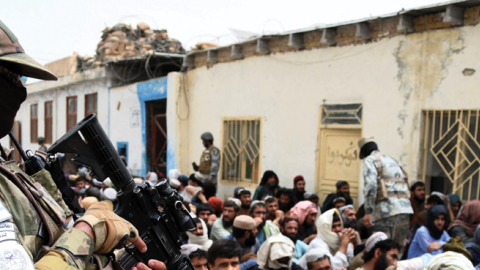A year ago this week, things were looking bad in Afghanistan, but nobody knew that the worst was yet to come. All US troops had just departed the country. The few remaining international troops were also on their way out. The Taliban already controlled half of Afghanistan’s districts and were threatening major cities. But few would have guessed that by Sept. 11, 2021, the Taliban would be in control of more of Afghanistan than it was on Sept. 11, 2001.
Since the Taliban takeover, Afghanistan has been on a downward spiral. There is an acute humanitarian crisis facing most Afghans. Even though the Taliban has promised that young girls can go to school, this still has not happened. Adding to the humanitarian crisis are the internal divisions inside the Taliban leadership and the overall security situation in the country.
The Taliban at the top is fractured. At least five different groupings — the Haqqani faction, the Baradar wing of the Kandahari faction, the Yaqoob wing of the Kandahari faction, the Pakistani ISI backed so-called Supreme Leader Hibatullah Akhundzada, and the non-Pashtun Taliban operating in northern Afghanistan — are all competing for influence and power with each other. With so much division inside the Taliban, any hopes of forming an inclusive government with other non-Taliban groups has all but faded away.
The security situation is hardly better. The Taliban takeover enabled terrorist groups such as Al-Qaeda and Daesh to flourish. Daesh has been able to take advantage of the chaos that emerged in some parts of the country when the Afghan state collapsed. Mass casualty terrorist attacks, often aimed at the Shiite Hazara minority, remain a common feature in Afghanistan.
Al-Qaeda also benefited from the Taliban’s takeover in Afghanistan. According to a recent report by the UN, “Al-Qaida members reportedly remain in the south and east of Afghanistan, where the group has a historical presence… Al-Qaida intended to establish a position in northern Afghanistan, mobilize new fighters and generate increased resources.” The report went on to state that Al Qaeda’s “leadership reportedly plays an advisory role with the Taliban, and the groups remain close.”
The broader region has also been impacted. Weapons from Afghanistan are finding their way to the bazaars in Kashmir. Of all the Central Asian states, Uzbekistan has been the most engaging with the Taliban. However, it is not clear that Tashkent has received any tangible benefits from this engagement. In fact, the security situation near the Afghan-Uzbek border has been deteriorating. Earlier this month five missiles fired from Afghanistan landed in the Uzbek city of Termez.
Meanwhile, neighboring Tajikistan has been the most critical of the Taliban. It is suspected that the Taliban is allowing Ansarullah, a Tajik extremist group with the stated goal of overthrowing the Tajik government, to patrol the Afghan border with Tajikistan. In recent months, there has been an increase in the presence of Tajik security forces mobilized along the border with Afghanistan.
Tajikistan has given tacit support to the National Resistance Front of Afghanistan (NRF). The predominantly ethnically Tajik NRF emerged in the Panjshir Valley in the wake of the Taliban takeover in August. Led by Ahmad Massoud, son of the late Ahmad Shah Massoud, the NRF is the only genuine resistance against the Taliban.
After surviving the Taliban’s initial offensive last autumn, and then surviving the winter months deep in Panjshir’s side valleys, the NRF has used the spring and summer to attack numerous Taliban positions in Baghlan and Panjshir Province.
In retaliation, the Taliban launched its biggest assault yet against the NRF a few weeks ago. Mullah Yaqoob, the de facto defense minister and son of Taliban founder Mullah Omar, led the operation. So far, this military offensive has failed. No NRF bases were taken. Taliban casualties were reportedly high. Even a Taliban helicopter was shot down.
Even though the only credible force inside Afghanistan to fight international terrorism is the NRF, nothing has been done by the US or its partners to build a relationship with them. In fact, last week the State Department even went as far as saying “We do not support organized violent opposition to the Taliban, and we would discourage other powers from doing so as well.”
US President Joe Biden’s decision to withdraw and abandon Afghan partners last year was a stain on America’s national honor. These comments from the State Department are yet another shameful slap in the face to the brave Afghans resisting the barbarism of the Taliban. After all, many of the NRF’s members are the same Afghanistan fighters that the US has trained and fought alongside for two decades.
The Taliban is too divided and incompetent to govern Afghanistan. As the Taliban’s brutality continues, more Afghans will support resistance groups like the NRF. Meanwhile, terrorist groups like Al-Qaeda and Daesh will be waiting for the best time to strike in all the chaos. Afghans will continue to starve, and the humanitarian situation will worsen. And there is no plan from the international community to do anything.
Unless something changes, Afghanistan will once again enter another generational cycle of violence and suffering.



















